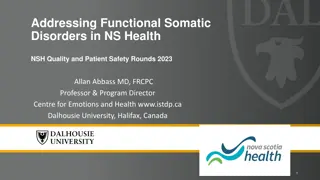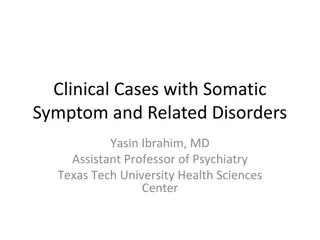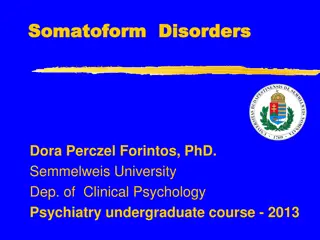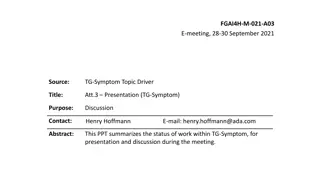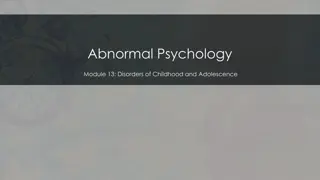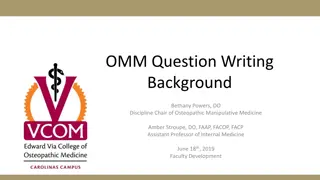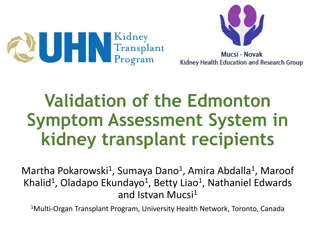Understanding Somatic Symptom and Related Disorders
Exploring the key features, diagnostic criteria, contributing factors, and management principles of Somatic Symptom and Related Disorders. This comprehensive guide covers the clinical manifestations, co-morbidities, and treatment approaches associated with these disorders, shedding light on somatic symptom disorder and distinguishing it from factitious disorders and malingering.
Download Presentation

Please find below an Image/Link to download the presentation.
The content on the website is provided AS IS for your information and personal use only. It may not be sold, licensed, or shared on other websites without obtaining consent from the author. Download presentation by click this link. If you encounter any issues during the download, it is possible that the publisher has removed the file from their server.
E N D
Presentation Transcript
Somatic Symptom and Related Disorders Terry McMahon, M.D. Sources: Diagnostic and Statistical Manual, 5thedition. (2014). American Psychiatric Publishing. Black, D., and Andreasen, N., (2014). Introductory Textbook of Psychiatry, 6thedition. American Psychiatric Publishing. 1
Learning Objectives Explain the key features, natural history, clinical manifestations and epidemiology of Somatic Symptom and Related Disorders. Describe the relevant psychiatric co-morbidity associated with Somatic Symptom and Related Disorders. Describe the general principles in managing patients with a Somatic Symptom and Related Disorders. Differentiate Factitious Disorders and malingering from each other and other Somatic Symptom Disorders. Describe the clinical manifestations of Factitious Disorders and a psychotherapeutic approach to treatment of these patients. 1. 2. 3. 4. 5. 2
Key Features Prominence of somatic symptoms associated with significant distress and impairment. Diagnosis based on positive symptoms and signs, rather than the absence of medical explanation for symptoms. Either-or vs Both-and approach. Medical and Psychiatric co-morbidity. Initial presentation mainly in medical setting. 3
Contributing Factors Genetic/Biological vulnerability (i.e. pain threshold) Early traumatic experiences (violence, abuse, deprivation). Somatization as a defense mechanism- conflict/anxiety reduction (primary gain). Sociocultural-sanctioned dependency. Interpersonal-manipulation/control of relationships, means of managing conflicts. 4
Additional Features Material gain-disability status, money (secondary gain). Frequent visits & doctor shopping . Frequent medical procedures issue of iatrogenic illness. Prevalence in 5-7% of general population Prevalence higher in females 5
Somatic Symptom Disorder Diagnostic Criteria One or more somatic symptoms that are distressing or result in significant disruption of daily life. Excessive thoughts, feelings, or behaviors related to the somatic symptoms or associated health concerns as manifested by at least one of the following: 1. Disproportionate and persistent thoughts about the seriousness of one s symptoms. 2. Persistently high level of anxiety about health or symptoms. 3. Excessive time and energy devoted to these symptoms or health concerns. Although any one somatic symptom may not be continuously present, the state of being symptomatic is persistent (typically more than 6 months) A. B. C. 6
Somatic Symptom Disorder Diagnostic Criteria-continued Specify if: With predominant pain (previously pain disorder): This specifier is for individuals whose somatic symptoms predominantly involve pain. Specify if: Persistent: A persistent course is characterized by severe symptoms, marked impairment, and long duration (more than 6 months). Specify current severity: Mild: Only one of the symptoms specified in Criterion B is fulfilled. Moderate: Two or more of the symptoms specified in Criterion B are fulfilled. Severe: Two or more of the symptoms specified in Criterion B are fulfilled, plus there are multiple somatic complaints (or one very severe somatic symptom). 7
Somatic Symptom Disorder Additional Features Onset in 20 s Low levels of education/income Often history of childhood sexual abuse. Familial association First degree female v. male relatives question of genetic factors. 8
Conversion Disorder Functional Neurological Symptom Disorder Diagnostic Criteria A. One or more symptoms of altered voluntary motor or sensory function. B. Clinical findings provide evidence of incompatibility between the symptom and recognized neurological or medical conditions. C. The symptom or deficit is not better explained by another medical or mental disorder. D. The symptom of deficit causes clinically significant distress or impairment in social, occupational, or other important areas of functioning or warrants medical evaluation. 9
Conversion Disorder Functional Neurological Symptom Disorder Diagnostic Criteria Specify symptom type: With weakness or paralysis With abnormal movement ( tremor, dystonic movement, myoclonus, gait disorder) With swallowing symptoms With speech symptom (i.e., dysphonia, slurred speech) With attacks or seizures With anesthesia or sensory loss With special sensory symptom (i.e., visual, olfactory, or hearing disturbance) With mixed symptoms 10
Conversion Disorder Functional Neurological Symptom Disorder Diagnostic Criteria Specify if: Acute episode: Symptoms present for less than 6 months. Persistent: Symptoms occurring for 6 months or more. Specify if: With psychological stressor (specify stressor) Without psychological stressor 11
Conversion Disorder Additional Features Present in up to 20-30% of patients admitted for neurological symptoms. More frequent in females. Associated with decreased levels of education and income. Usual onset is late childhood and early adulthood. Symptoms conform to patient s concept of disease. 12
Conversion Disorder Additional Features Can coexist with other physical d/o; i.e. later dx of neurologic d/o not uncommon (20- 60%). Problem with classical findings -(i.e., secondary gain, histrionic personality, la belle indifference). Conversion V on MMPI Better prognosis acute onset, clear precipitant, good pre-morbid adjustment, absence of medical/neurological co- morbidity. 13
Illness Anxiety Disorder Diagnostic Criteria A. Preoccupation with having or acquiring a serious illness. B. Somatic symptoms are not present or, if present, are only mild in intensity. If another medical condition is present or there is a high risk for developing a medical condition (i.e., strong family history is present), the preoccupation is clearly excessive or disproportionate. C. There is a high level of anxiety about health, and the individual is easily alarmed about personal health status. 14
Illness Anxiety Disorder Diagnostic Criteria D. The individual performs excessive health-related behaviors (i.e., repeatedly checks his or her body for signs of illness)or exhibits maladaptive avoidance (i.e., avoids doctor appointments and hospitals). E. Illness preoccupation has been present for at least 6 months, but the specific illness that is feared may change over that period of time. 15
Illness Anxiety Disorder Diagnostic Criteria F. The illness-related preoccupation is not better explained by another mental disorder, such as somatic symptom disorder, panic disorder, generalized anxiety disorder, body dysmorphic disorder, obsessive-compulsive disorder, or delusional disorder, somatic type. Specify whether: Care-seeking type: Medical care, including physician visits or undergoing tests and procedures, is frequently used. Care-avoidant type: Medical care is rarely used. 16
Illness Anxiety Disorder Additional Features Amplification/misinterpretation of normal function. Preoccupation with illness undermining socio-occupational function and relationships. Prevalent in 3-10% of general population Onset early to middle adulthood. Doctor shopping , frequent medical visits, excessive medical procedures. 17
Psychological Factors Affecting Other Medical Conditions Diagnostic Criteria A medical symptom or condition (other than a mental disorder) is present. B. Psychological or behavioral factors adversely affect the medical condition in one of the following ways: 1. The factors have influenced the course of the medical condition as shown by a close temporal association between the psychological factors and the development of, exacerbation of, or delayed recovery from, the medical condition. 2. The factors interfere with the treatment of the medical condition (i.e., poor adherence). 3. The factors constitute additional well-established health risks for the individual. 4. The factors influence the underlying pathophysiology, precipitating or exacerbating symptoms or necessitates medical attention. A. 18
Psychological Factors Affecting Other Medical Conditions Diagnostic Criteria C. The psychological and behavioral factors in Criterion B are not better explained by another mental disorder (i.e., panic disorder, major depressive disorder, posttraumatic stress disorder). Specify current severity: Mild: Increased medical risk (i.e., inconsistent adherence with antihypertension treatment). Moderate: Aggravates underlying medical condition (i.e., anxiety aggravating asthma). Severe: Results in medical hospitalization or ER visit Extreme: Results in severe, life-threatening risk (i.e., ignoring heart attach symptoms.) 19
Psychological Factors Affecting Other Medical Conditions Examples include: Denial/minimization of disease Poor compliance/adherence Symptom increase due to anxiety (i.e. asthma) Inappropriate medication use (manipulation of insulin to achieve weight loss) 20
Differential Diagnosis of Somatic Symptom and Related Disorders A. Importance of: 1. Understanding natural history of the disorders 2. Good psychosocial history B. Frequent Co-Morbid Psychiatric Disorders- Major depression, Anxiety D/O, Substance use disorder, Adjustment disorder (grief reaction), Personality traits/disorders- (histrionic, antisocial, dependent/avoidant, obsessive compulsive), Schizophrenia, Delusional disorder. 21
Differential Diagnosis of Somatic Symptom and Related Disorders C. Physical Disorders 1. A mixture of physical/psychiatric disorders not uncommon. 2. Problems with secondary gain, diagnosis by exclusion, either/or approach. 3. Especially look for endocrine, neurologic, collagen/vascular, and occult neoplastic disease. 22
Clinical Management of Somatic Symptom Disorders The clinical presentation is considered in the context of psychosocial factors, both current and past. The diagnostic procedures and therapeutic interventions are based on objective findings. (i.e., primum non nocere first, do no harm ) A therapeutic alliance is fostered and maintained involving the primary care and/or psychiatric physician. 23
Clinical Management of Somatic Symptom and Related Disorders The social support system is carefully reviewed during each patient contact. A regular appointment schedule is maintained for outpatients, irrespective of clinical course. This facilitates development of a therapeutic alliance and safer, cost- effective care. 24
Clinical Management of Somatic Symptom and Related Disorders The significance of personality features, addictive potential, and self-destructive risk is determined and addressed. The patient s care is redefined in such a way that management rather than cure is the goal of treatment. 25
Psychiatric Referral and Psychotherapeutic Management In-addition-to rather than instead of follow-up by primary physician. More supportive with emphasis on coping rather than insight , i.e. identification and management of stress . Medications identify specific target symptoms. Attend to family dynamics/behavior. Monitoring risk for iatrogenic illness. 26
Factitious Disorders and Malingering Diagnostic Distinctions Symptoms production voluntary (i.e., conscious) and deceptive in both. Difference in goals clear external incentives (money, avoidance of work/duty, etc.)in Malingering v. achievement of patient role in Factitious D/O. 27
Factitious Disorder Diagnostic Criteria Factitious Disorder Imposed on Self A. Falsification of physical or psychological signs or symptoms, or induction of injury or disease, associated with identified deception. B. The individual presents himself/herself to others as ill, impaired or injured. C. The deceptive behavior is evident even in the absence of obvious external rewards. 28
Factitious Disorder Diagnostic Criteria D. The behavior is not better explained by another mental disorder, such as delusional disorder or another psychotic disorder. Specify: Single episode Recurrent episodes (two or more events of falsification of illness and/or induction of injury). 29
Factitious Disorder Diagnostic Criteria Factitious Disorder Imposed on Another (Previously Factitious Disorder by Proxy) A. Falsification of physical or psychological signs or symptoms, or induction of injury or disease, in another, associated with identified deception. B. The individual presents another individual (victim) to others as ill, impaired, or injured. 30
Factitious Disorder Diagnostic Criteria C. The deceptive behavior is evident in the absence of obvious external rewards. D. The behavior is not better explained by another mental disorder, such as delusional disorder or another psychotic disorder. Note: The perpetrator, not the victim, receives this diagnosis. Specify: Single episode Recurrent episodes (two or more events of falsification of illness and/or induction of injury). 31
Factitious Disorder Additional Features Onset early adulthood. May become chronic (i.e., Munchausen males ) Often associated with Personality Disorders Possible association with healthcare occupations (i.e., episodic pattern). 32
Developmental/Psychodynamic Theories in Factitious Patients Early deprivation/insecurity. Delays in psychosexual development, antisocial/delinquent behavior. Core conflicts related to self-esteem, dependency, mastery, masochism. Behavior as repetition-compulsion , (i.e., attempt to recreate/resolve above conflicts). 33
Factitious Disorder Management Behavior as cry for help . Coping with counter transference. Positive prognostic features other Axis I D/O, some social supports, ability to cope with confrontation, establish rapport. Non-punitive confrontation; importance of timing. Attempts to redirect patient to more appropriate interventions, sources of assistance. 34
When considering a diagnosis of Somatic Symptom Disorder, which of the following is most important regarding a diagnosis? Absence of a pathologic or pathophysiologic explanation for the symptoms. Demonstrated pursuit of secondary gain by the patient. A high level of anxiety and recurrent visits to physicians as a result of the symptoms. Onset of symptoms in the fifth decade of life (40 s). Male gender A. B. C. D. 0% 0% 0% 0% 0% E. A. B. C. D. E. 35
Patients with Conversion Disorder: Will not have subsequent medical or neurologic disease. Have symptoms that conform to the patient s concept of disease. Are associated with increased levels of education and income. Usually have onset of symptoms in late adulthood. Rarely have symptoms related to voluntary motor or sensory functions A. B. C. D. E. 0% 0% 0% 0% 0% A. B. C. D. E. 36
Among patients with Factitious Disorder: Patients knowingly and intentionally feign signs and/or symptoms of disease. Financial reward or similar material gain is the motivating factor. Patients are generally well adjusted, socially conforming males. Patients seek to avoid medical investigation of symptoms. A. B. C. D. 0% 0% 0% 0% A. B. C. D. 37
Conclusions Somatic Symptom and Related Disorders though not disease per se, these are illnesses which warrant intervention and treatment. Goal make interactions with health care system more beneficial, therapeutic and safer for the patient and less ambiguous and frustrating for the physician. 38


